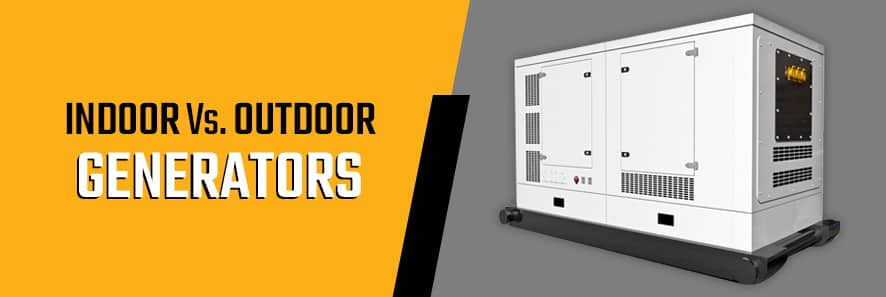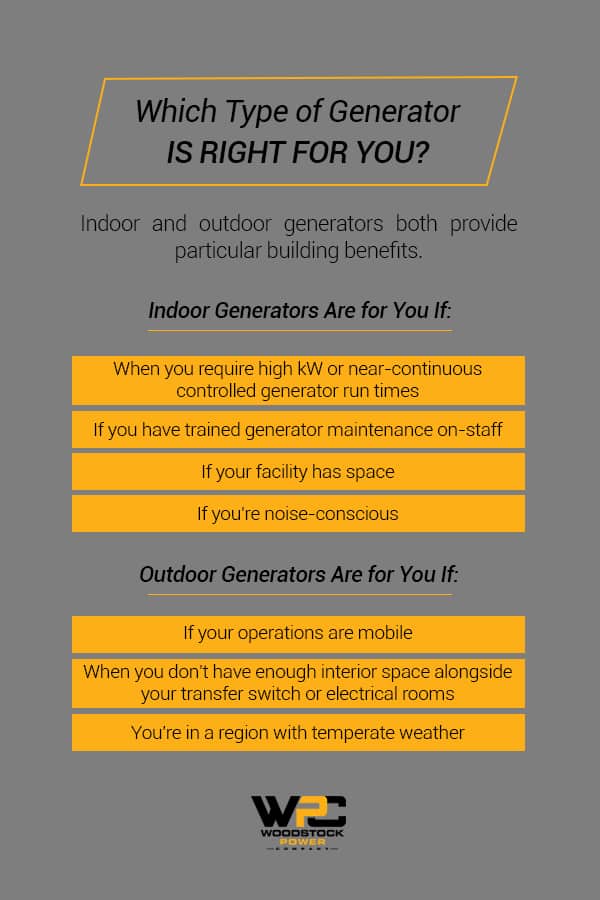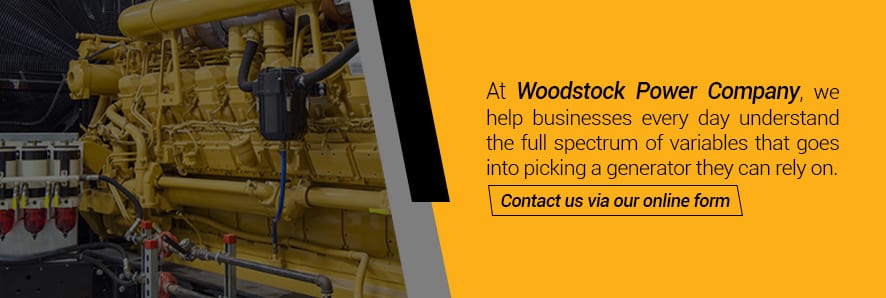Indoor Versus Outdoor Generators

Indoor or outdoor generator installation — that is the question. At least, that’s the question for business owners, managers, building operators and system coordinators selecting the ideal prime and standby generators for their exact building.
This is no small decision, either. Picking the wrong generator can mean operational disruptions, building damage — even regulatory fines, accidents and cease operation notices effective immediately.
Knowing the differences between indoor and outdoor generators assures your reputation — not to mention employees’ and customers’ safety — are prioritized, always. Explore our indoor versus outdoor generator guide to get started.
First Things First: Indoor Versus Outdoor Generator Placement
As their names suggest, indoor and outdoor generators have a crucial difference — installation location. Determining the ideal placement for your commercial generator will primarily come down to building safety and compliance ordinances.
Organizations opt for outdoor generators under several specific circumstances. Meet the following criteria, and a company can initiate the process of receiving a permit and installing a generator on their property:
A building or business applies and receives a permit from its municipal buildings department.
- A building or business applies and receives a permit from its municipal buildings department.
- The outdoor generator’s installation plans meet all local and state regulations, zoning requirements and city ordinances, including noise ordinances.
- Your commercial property has a suitable installation environment, namely a concrete pad foundation for your generator separating the unit from mud, dirt and ground debris, as well as maintaining safety compliance.
- Your commercial property has suitable sound attenuation, fancy industry jargon for a suitable generator enclosure. Sound attenuated enclosures help keep outdoor generators in compliance with local noise ordinances and usually come with weatherproof features that protect the unit from inclement weather and environmental damage.
Commercial generators can be used indoors. Indoor generators are an attractive option for many industries and business types when they meet the following criteria:
- The size of their facility or the scale of their operations necessitates indoor primary or contingency power — for example, medical facilities and multi-building hospital campuses or large-scale industrial or manufacturing plants. Often this correlates with state or federal regulations outlining standby or contingency indoor generator systems.
- Your business’ insurance company agrees to cover the indoor generator system.
- Your facility’s design can handle heat and fume ventilation produced as a result of fuels, exhaust, generator lubrication and starting battery operations via proper generator room requirements.
- Proper fuel intake controls and adapters are available.
- Building fire codes are observed.
In general, more organizations opt for commercial outdoor generator installation due to ease of installation process and less worries about dedicating a room specifically for a stationary generator. While all generator types can be hazardous if not properly maintained, indoor generators must have their own dedicated generator room due to ventilation requirements, as well as logistical requirements to prevent employees and visitors from easily accessing the generator. Additionally, dedicated generator rooms must be located away from employees to prevent the loud noise produced by the generator from negatively affecting them. Setting up a generator room will not only involve a master electrician, but also building design planners and mechanical engineers which can add in more costs and challenges. Outdoor industrial units generally require fewer structural changes made to a building — and fewer building codes must be met, though they still are in effect — for compliant, safe installation. This also means outdoor generators tend to be cost-friendlier up front.
Benefits of Indoor Generators
Indoor generators are always installed inside building-code compliant generator rooms.
Outfitting these generator rooms is the fundamental process of establishing a high-functioning commercial indoor generator. Once equipped, these power generators carry a range of distinct advantages ideal for industrial applications.
1. Controlled Climate
Indoor generators are sheltered from harsh weather damage like rain, snow, ice and thunderstorms. It’s imperative to keep generators within their spec-assigned operating temperature ranges since life-safety regulations mandate generators power up to building loads within 10 seconds. Generators will not be able to do so in uncontrolled climates.
This environmental protection also extends to other environmental wear and tear more common with outdoor installed units, such as:
- Overheating: Even outdoor units with proper generator enclosures can face temperature problems during hot weather, lacking enough air circulation to cool components.
- Leaves: Leaves and other foliage must be systematically removed from an outdoor generator’s enclosure, whereas indoor generators don’t come into contact with any brush.
- Ice: Ice damming is a necessity for all outdoor generators, ensuring ice crystals and formations do not set into interior generator components and cause lasting damage. Indoor generators are sheltered from contact with snow and ice.
2. Security
Indoor generators are protected from the environment and are isolated from any kind of “outside” tampering.
Heightened system security is particularly attractive for data centers, telecommunications and medical facilities. The two former industries require smooth, uninhibited 24/7/365 operations to stay compliant, while the latter cannot use medical equipment to perform life-saving functions without power.
However, given their location inside a facility and subsequent occupant proximity, indoor generators must follow a stricter set of generator room design requirements. Yet it’s these very requirements which enhance their security:
- Accessible transfer switches and paneling: For proper load start-up, power-off, distribution and load modification control.
- Sprinkler systems: In case of fire or heat emergencies.
- Two-hour fire rating: A fire vault classification system that means a room has been designed to contain and withstand fires for up to two hours.
- More frequent maintenance checks and testing: Some indoor systems require up to four maintenance inspections a year, investigating fluid levels, load banks, batteries, filters and more.
3. Noise Reduction
Indoor generators can employ more noise control solutions. Installation can use current building structures and materials to reduce the amount of noise and vibrations innate with any kind of generator — diesel or natural gas, standby or primary.

The best noise reduction strategy for indoor generators is an indoor sound attenuation system, meaning a generator room designed with holistic sound-mitigating features:
- Room location: It’s a best practice to build generator rooms in less frequently occupied or peripheral parts of a facility.
- Generator location: Contemporary sound attenuation can help orient the exact placement of a generator, strategically positioning the unit’s sound radius to emit as little long-range noise pollution as possible.
- Exhaust mufflers and silencers: Alongside engines and radiator fans, generator exhaust creates the most noise. System-built mufflers and silencers can dramatically reduce exhaust sound disturbances.
4. Exhaust Fume Controls
Exhaust fumes cannot mix with a facility or building’s HVAC air intake system. While this is a risk for all generator types, outdoor units cannot be configured with fully custom, compliant spacing between generator fume exhaust controls and HVAC air intake like indoor generators can.
The additional architectural attention given to indoor generator rooms helps alleviate exhaust fume permeation problems. Interior generator rooms are designed with isolated exhaust piping, as well as absorption filters. Outdoor units cannot so readily employ these designed systems without significant facility renovations.
Building and installing a dedicated indoor generator room requires assistance from building contractors and mechanical engineers. These experts should be fluent in indoor generator systems and regulations, providing your facility the utmost security — and you with peace of mind.
Benefits of Outdoor Generators
Outdoor prime and back-up power generators court their own list of advantages, too, particularly for small-to-medium-sized businesses or standard-sized, non-industrial facilities.
1. Cost
Outdoor generators are nearly always more cost-conscious. This is due in large part to their installation nature. Rather than building and configuring an entire room dedicated to housing a compliant large-scale generator, businesses install turn-key commercial units.
Electrical or mechanical engineers are a great resource to receive a third-party cost estimate on your outdoor generator project. They can perform on-site inspections to assess your business’ kW-capacity needs, suitable transfer switch locations, exhaust system components and electrical connection points. This, in turn, helps inform the best size and location for your outdoor generator that will provide a Goldilocks match for your current building configuration.
2. Scale and Flexibility
The majority of commercial businesses and offices may not require a full-fledged interior generator system.
Now, this is not to say outdoor systems aren’t as powerful or don’t provide the full capacities an interior generator does. Depending on your generator model and its subsequent kW generation, this isn’t true.
Rather, the size of most commercial buildings makes an outdoor generator a far more natural choice — and, again, the cost-appropriate one. Standard storefronts and offices may not have the room to install a compliant indoor generator without major renovations. Other types of outdoor generators, including portable rental generator units are also designed to help accommodate backup power solution needs to these business storefronts and office spacing without the need of a permanent generator installation. Simply put, a portable commercial generator can be rolled onto the premises, connected to the main electrical circuit, and then removed off the premises easily to avoid zoning regulation infractions.

Well-maintained outdoor generators best support the following small and medium-sized businesses:
- Restaurants, cafes and coffee shops
- Grocery stores
- Property management
- Department or retail stores
- Small to medium-sized offices
- Banks
- And more
3. Installation Turnaround
Outdoor generators can be installed in as little as a week if most site preparation is complete and permits are already prepared. As an industry rule of thumb, the lower the generator’s kW outputs, the quicker the installation timeline will be.
Outdoor generator installation generally follows these steps:
- Site/building inspection
- Site preparation
- Permit application and approval
- Generator order
- Generator delivery
- Generator set-up and installation, including completing essential connections to natural gas fuel lines, electric lines and transfer switch paneling systems
- Sound attenuation and security details, such as fences or sound-absorbing yet properly distanced landscaping or hardscaping
Indoor generators carry all these steps — and then some. Preparing a facility for an indoor generator also includes measures like insurance coverage and contract changes, building construction and sometimes demolition, additional sound attenuation systems, extra building vibration resistance and more detailed spacing and preparation among interior fuel lines, electrical connections and HVAC systems.
4. Optional Distance
Outdoor generators have the added advantage of being installed away from a building, therefore reducing noise pollution and disturbances due to vibrations.
Just remember — outdoor units still need to feed into transfer switches and emergency paneling, which are often located in remote rooms within the business or building. For safety purposes, that transfer room should be separated from the electrical utility room. The farther removed a generator is from the building, the more complex these feeds will be.
Note that interior generators must still be aligned with local building codes. Similar to indoor units, you must submit a permit package to your municipal building department with all necessary information and documentation before installing your outdoor commercial generator. When in doubt, always consult with an electrical or structural engineer to help navigate your city’s particular zoning laws.
Which Type of Generator Is Right for You?
Indoor and outdoor generators both provide particular building benefits.
So which is better? Consider the following scenarios to get an accurate sense of the most functional and cost-appropriate unit for your organization.

1. Indoor Generators Are for You If:
Opt for indoor prime and standby generators:
- When you require high kW or near-continuous controlled generator run times: The controlled climates, security and immediate, in-building access of indoor generators makes them ideal for facilities in need of hyper-dependable, high load reliance. Think data centers, assisted living homes, medical facilities, industrial food refrigeration and airports whose operations could unravel after even a few minutes of lost power.
- If you have trained generator maintenance on-staff: Indoor generators will require additional maintenance activities and tests. Their location puts your building more at risk for things like carbon monoxide leaks and other dangers if generator systems are not properly maintained. Trained maintenance staff can also provide subject matter expertise over manual generator operations, such as flipping power switches on and off if your unit doesn’t include an automatic transfer switch (ATS).
- If your facility has space: Indoor generators tend to require more square footage dedicated to the generator room, plus additional space for possible sound attenuation, temperature and climate control infrastructure, such as remote air-cooling systems, and proper air ventilation. What’s more, these units are the least disruptive when stationed in peripheral rooms or building areas and should be installed in these locations whenever possible.
- If you’re noise-conscious: Indoor generators don’t have to contend with neighborhood noise ordinances. Generator rooms can be outfitted with additional noise and vibration-reducing features unavailable to outdoor units.
2. Outdoor Generators Are for You If:
Consider new or refurbished outdoor generator units:
- If your operations are mobile: Construction fleets, architects, emergency crews and disaster-relief operations require generators that are weatherable and environmentally hardier — and therefore suited for the outdoors — and they may need mobile outdoor generators.
- When you don’t have enough interior space alongside your transfer switch or electrical rooms: Many standard commercial buildings, storefronts and restaurants simply don’t have the room for interior generator systems. Outdoor units will still need to connect with transfer switch rooms, panels and electrical systems, but don’t need to be architecturally harmonized indoors with them.
- You’re in a region with temperate weather: While factors like wind and rain effect generators everywhere, more temperate climates offer a hospitable and stable environment for your unit. In particular, areas prone to flooding or hurricanes may want to include extra protective infrastructure for their outdoor generators.
Learn How to Pick the Right Indoor or Outdoor Generator for Your Business
There’s no such thing as being overprepared, not when it comes to your business’ reputation — and real people’s safety.
These considerations are just a few on the line when determining whether an indoor versus outdoor generator is right for your organization, office or facility. Here at Woodstock Power Company, we help businesses every day understand the full spectrum of variables that goes into picking a generator they can rely on.
Our extensive new and used generator inventory combines with industry experts who can assess any of the following for your business:
- Standard as well as peak load requirements
- Fuel types and affordances — natural gas or diesel
- Mobile or portable needs as well as stationary power
- Prime and backup power requirements
- Industry-specific compliance mandates
- Facility space, ventilation and exhaust capacities
- Renting or purchasing options
- New or quality-testing, refurbished generators
- And more
Ready to have your generator questions answered once and for all? Contact Woodstock Power Company via our online form or at (610) 658-3242. We’d love to lend answers and insights — and be your generator power partner.


